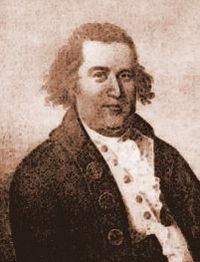William Dawes Jr (April 6, 1745 – February 25, 1799) was born in Massachusetts Bay Colony and is one of the many riders that rode to alarm the militia leaders of the marching British soldiers. His alarm happened prior to the Battles of Lexington and Concord and allowed the minutemen to muster. Unfortunately, Paul Revere is the one remembered for the ride, and Dawes tends to be left out, as does the forty other riders. Dawes went on to serve his country in the Boston militia. He was instrumental in acquiring the necessary artillery from the British redcoats and served in other capacities as well. Like many of his fellow New Englanders, as the war’s theatre move towards the middle and southern colonies, their names show up less frequently.

Jump to:
William Dawes: The Ride
Dr. Joseph Warren assigned two men to carry the warning of the British movement to John Hancock and Samuel Adams, Paul Revere and William Dawes.
William Dawes was a tanner whose business took him through the narrow gate into Roxbury. The British officers were familiar with him, which is probably why he was chosen to deliver the message. It is uncertain how he managed to get passed the gate. Perhaps, as suggested, he knew the guards, or he attached himself to a sentry unit. Whatever the reason, he got through the gate.
Dawes rode south across the Boston Neck to Roxbury. He then slowly rode through Brookline, Brighton, Cambridge, Menotomy, and Lexington. His route was approximately 17 miles longer than Revere, and he rode on a slower horse. He completed his mission when he arrived at the Hancock-Clarke Parsonage shortly after Paul Revere.
Dawes and Revere set out from Lexington Greene to alarm the rest of the countryside. On their way, they met a man who had been out courting the beautiful Lydia Mulliken, Dr. Samuel Prescott. Upon talking to him, they learned that he was a “high Son of Liberty” and recruited him to alarm the city of Lincoln. Shortly after his recruitment, the three men were apprehended by a British guard. Paul Revere was captured, but Dawes and Prescott were able to escape.
During Paul Revere’s capture, Dawes shouted, “Halloo, my boys, I’ve got two of them,” which caused the British to chase after Prescott and Revere while Dawes rode off in the other direction. He rode towards an abandoned house, and his horse became frightened and threw him off his back. Dawes hit the ground hard, losing his watch and his horse as it galloped into the darkness. Tired and hurt, Dawes’ ride was over. He walked back to Lexington, keeping in the shadows and out of sight.
He served faithfully as a quartermaster during the war and resumed a normal life.
Unfortunately, William Dawes is often forgotten in the tale of Paul Revere. He is another casualty of the Henry Wadsworth Longfellow poem, which made Paul Revere the lone rider that night. While Dawes did not have the influence of Revere, he did have his bravery, and he completed the mission that was given to him by Dr. Joseph Warren. He did not alarm the towns that he rode through, and that should be noted. Even so, he should not be forgotten as he, too, risked his life for the American cause, although it was not “American” for about a year later.
William Dawes Facts: Later Years
William and Mehitable Dawes would have three children: two sons and a daughter. His wife died in 1793, and six years later, on Feb 25, 1799, Dawes passed away in Marlborough, Massachusetts. His Great-great-great-grandson Charles Gates Dawes would become Vice President of the United States during Calvin Coolidge’s Presidential term.
After his death, the poem “Paul Revere’s Ride” was written, and it would overstate the role of Paul Revere, effectively cutting out William Dawes, Samuel Prescott, and many others. Paul Revere did play a more significant role than Dawes, but it should be noted that Dawes and Prescott were more successful in achieving their actual missions. In 1995, David Hackett Fischer wrote the book Paul Revere’s Ride, which would clear up the misconceptions that the poem caused
